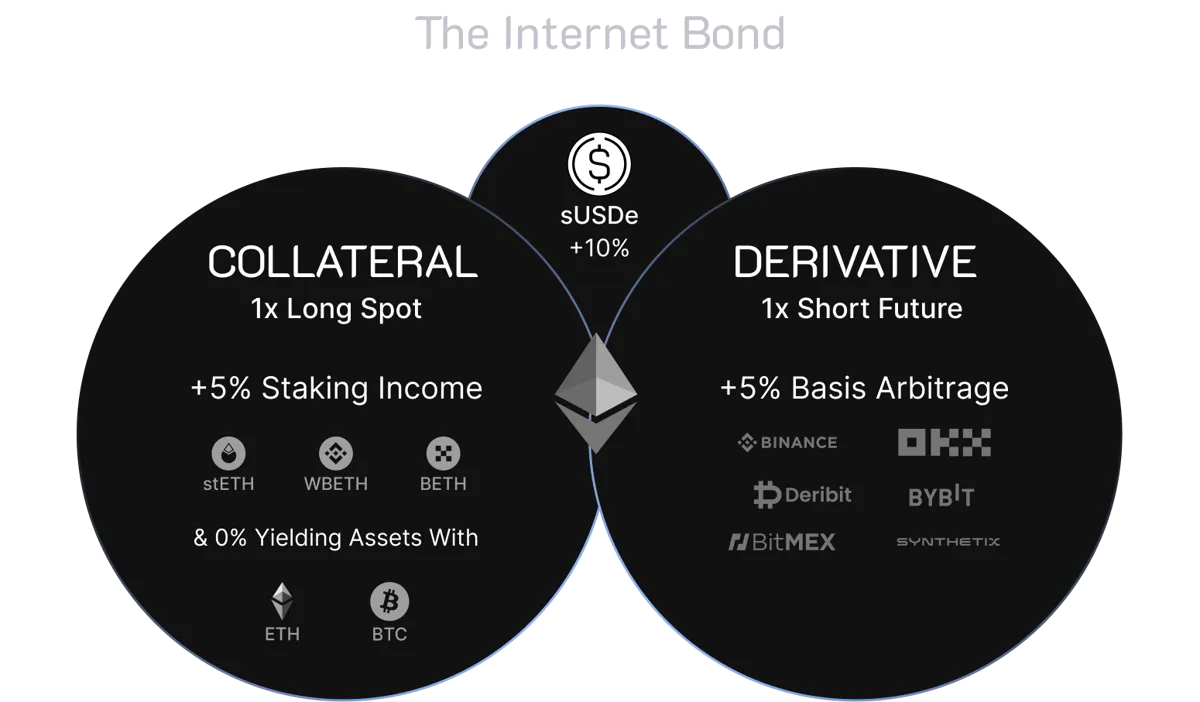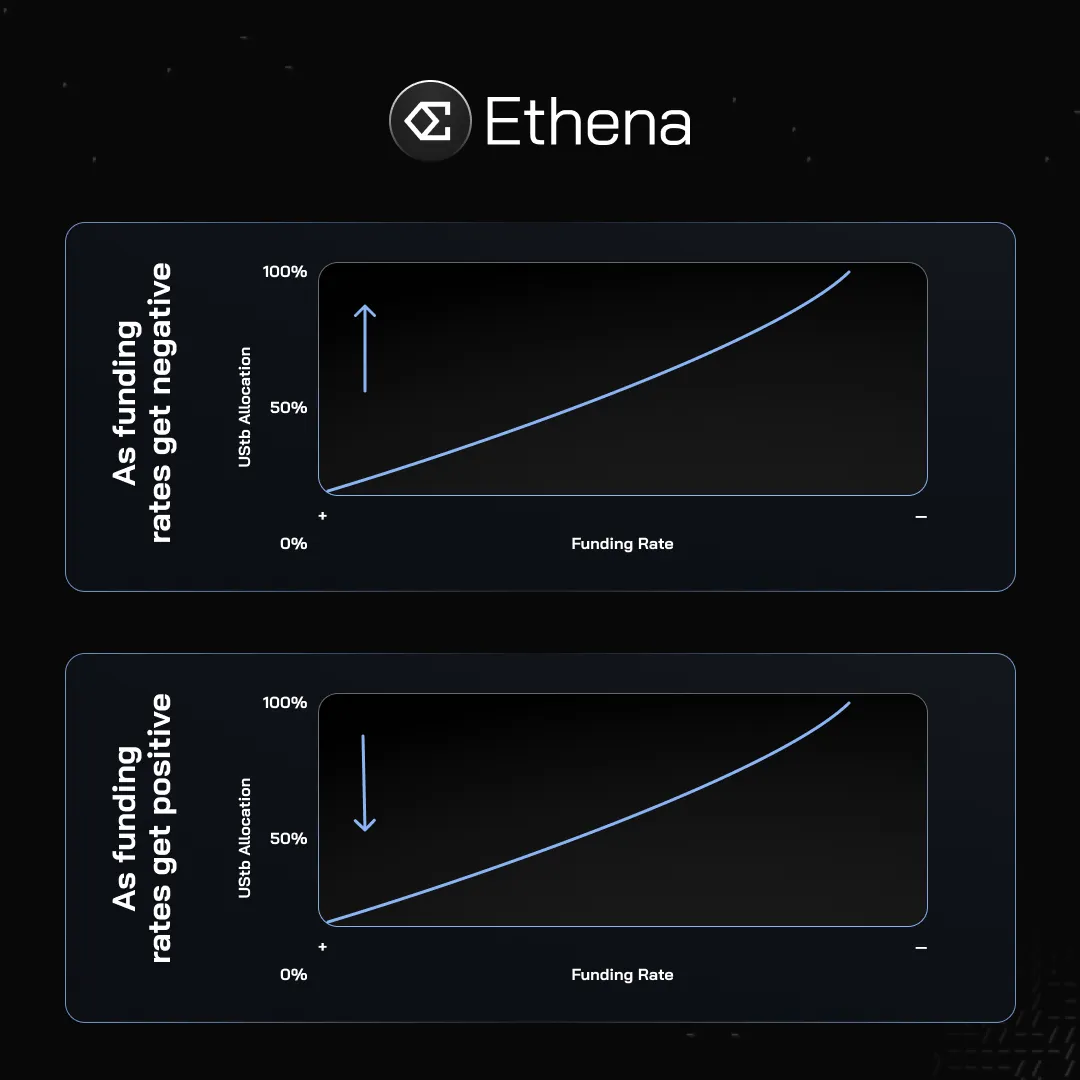Is Ethena's yield sustainable? This question often arises in the crypto community, particularly among Korean investors. My answer is "Yes" — the risks are low and actively managed. In this article, we'll explore the risks associated with Ethena's sUSDe yield and discuss what the recent announcement of their new product, UStb, means for Ethena. We'll also look at Ethena's future prospects in light of several upcoming crypto dollar protocol launches.
Ethena's staked USDe, sUSDe, generates yield through three main sources:
Staking Rewards: It earns from underlying collateral like stETH (staked Ethereum), providing a base yield from Ethereum's proof-of-stake system.
Market Strategies: It profits from funding and basis spread in perpetual and futures markets. It uses a delta-neutral approach with long positions in spot assets and short positions in perpetual futures. This approach allows the protocol to capitalize on typically positive funding rates, where long position holders pay short position holders.
Stable Coin Yields: Ethena generates fixed rewards from two stable coin sources. First, it earns from 295m USDC through Coinbase's loyalty program. Second, it receives income from 400m sUSDS via Sky protocol's (formerly known as Maker) borrowing fees.

Source: Protocol Revenue Explanation | Ethena Labs
The yield generation mechanism carries risks, particularly regarding "negative funding rates" in its delta-neutral strategy. Negative funding rates pose a threat to the Ethena protocol by potentially eroding revenue and leading to losses. In such scenarios, the protocol must pay periodic payments instead of receiving them, indicating more traders are taking short positions than long. This can result in reduced yields on USDe and potentially decrease USDe supply as users seek better returns elsewhere.
Ethena has implemented several measures to mitigate risks associated with negative funding rates:
Reserve Fund: A $39 million safety net covers losses during negative funding periods. This fund activates when negative rates exceed collateral yield, protecting the sUSDe holders from losses.
Yield Buffer: Staked collateral yield (e.g., from stETH) and yields from liquid stables (i.e., USDC, USDS) cushion against moderate negative funding rates.
UStb Stablecoin (This is in Progress): Ethena's new UStb, backed by Blackrock BUIDL, is planned to act as a strategic safeguard. During negative funding periods, Ethena can shift reserves to UStb, reducing exposure to costly perpetual futures contracts in favor of more stable, US treasury bill-backed assets.
The protocol also relies on the historical tendency of funding rates to revert to a positive mean, with data showing that negative funding periods are typically short-lived. However, as Ethena grows substantially, its size may introduce additional risks.

Source: Yields | Ethena
Stablecoins have found a strong product-market fit in the crypto industry. With a daily transaction volume of around $30 billion, issuers are reaping substantial profits. Due to this opportunities, there are more enterprise and protocols that are planned to lauch their crypto dollar.
As competition intensifies, Ethena stands as a crypto dollar that offers one of the highest yields due to its strategy. To gauge its continued momentum, two key factors should be monitored:
The collateral allocation strategy of USDe and its expansion plan
The evolving competition in the stablecoin industry

Source: Positions | Ethena
Ethena has implemented proactive measures to address potential negative funding rates. These measures include allocating liquid stables (i.e USCD, USDS) for stable yields. Tracking these allocations over time is crucial, as they serve as the primary collateral for USDe.
Recently, Ethena introduced "UStb" (US Treasury Bill), a new product fully backed by Blackrock's BUIDL token. This is a smart move, since this strategic move not only diversifies Ethena's product range but also provides collateral for sUSDe to maintain stable yields. In scenarios where funding rates approach negative territory, Ethena's governance can adjust UStb allocation as collateral.
Yield bearing has found its PMF, these projects represent the emerging trend of yield-bearing stablecoins, offering users both stability and potential for passive income. There will be more stablecoin projects, and competition and providing better yield or incentive will be a strategy.
The proliferation of yield-bearing crypto dollars has emerged as a significant trend in the market. Notable examples include sDAI by MakerDAO, which launched on May 9, 2023, and accrues interest from the Dai Savings Rate (DSR), and USDY by Ondo Finance, a tokenized note that combines stablecoin stability with yield potential generated from short-term US Treasuries and bank deposits.
Other prominent players in this space include USDS by BitGo, announced for launch in January 2025, which aims to redistribute up to 98% of earnings to ecosystem participants and is backed by Treasury bills, overnight repos, and cash. Additionally, deUSD by Elixir, launched on August 8, 2024, is built upon delta-neutral strategy. The market anticipates further expansion with potential announcements from major financial technology companies such as Revolut and Robinhood, signaling a growing interest in yield-bearing stablecoins across the industry.
Ethena has been the fastest-growing crypto dollar in the industry. As similar offerings become more diverse, it will be important to monitor their future strategy, including their Ethena L2 launch.
A primary concern from the community about USDe has been its response to negative funding rate environments. However, despite bearish conditions over the past six months, Ethena sUSDe hasn't experienced a single week of negative funding.
If needed, USDe's backing composition can dynamically adjust between basis positions and liquid stable products in varying interest rate environments. During periods of weak funding conditions, USDe can benefit from incorporating UStb.
In negative funding conditions, if governance deems it necessary and appropriate, Ethena can close hedging positions and reallocate those backing assets to UStb. This action further mitigates risks associated with negative funding rate environments.

Source: X (@ethena_labs)
Related Articles, News, Tweets etc. :
Dive into 'Narratives' that will be important in the next year